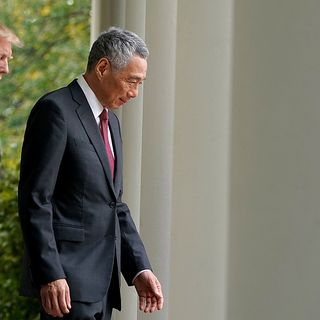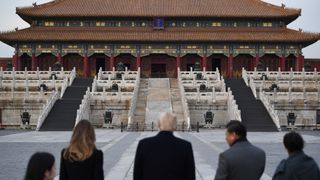Introduction
Since Donald Trump entered the White House with an “America first” agenda, the shape of United States’ strategic policy in Indo-Pacific Asia has become a pressing concern for regional allies and partners. His administration’s performance over the past nine months has only partially allayed these anxieties. Trump’s rejection of the Trans-Pacific Partnership and “rebalance to Asia,” along with his deep scepticism about the liberal internationalist aims of US Asia policy, have stoked fears of a US retreat from regional leadership. At the same time, the administration’s inconsistent approach to China and the North Korean nuclear crisis have failed to reassure the region that strategic challenges will be effectively managed. While there have been areas of welcome continuity — such as Trump’s early reiteration of support for America’s principal Asian alliances — it appears that the administration is pursuing a more narrowly self-interested Asia policy, making America’s strategic presence in the region more brittle.
Donald Trump has a mission in Asia, but it's not the one his allies want

President Trump’s first trip to Asia in November 2017 provides an opportunity to recalibrate policy. Arguably the core problem in the administration’s approach to Asia so far has been its failure to articulate an integrated regional strategy — one that links economic, diplomatic, and military policies around a clear set of US strategic objectives in Asia. If Trump fulfils his promise to deliver a “vision for a free and open Indo-Pacific region” at the APEC Leaders’ Summit, he may start to reassure US partners that his administration has a plan for the region1. But this will not be easy. In the wake of Barack Obama’s rebalance — which gave much-needed direction to Washington’s Asia strategy, even as it failed to realise its full potential — the region was holding out for a stronger rebalance under Hilary Clinton2. Trump’s “America first” agenda has not only dashed these hopes. It has also played into deeper structural questions about America’s ability to sustain its regional position amid political dysfunction, defence budget shortfalls, military overstretch, and an increasingly competitive China3. Only an administration with a clear-eyed sense of America’s strategic priorities in Asia will be able to muster the political will and resources to address these challenges.
An Asia team still in the making
Although there are several highly competent officials in Trump’s national security team, it lacks a dedicated champion for Asia policy—someone with the vision and authority to develop a whole-of-government strategy for the region. By all accounts, Secretary of Defense James Mattis is committed to prioritising the Pentagon’s role in a post-rebalance Asia strategy. As the most status quo figure in cabinet, Mattis supports the provision of economic and political assistance to vulnerable US partners, opposes China’s efforts to coerce its neighbours into a regional “tributary system”, and holds an internationalist vision of America’s security objectives in Asia4. But he is not in a position to deliver on the non-defence aspects of an integrated strategy. Secretary of State Rex Tillerson could play this role, but is marginalised within the administration and preoccupied with a major restructuring of the State Department5. In any case, while Tillerson supports conventional positions on US allies, non-proliferation, freedom of navigation, and the TPP, it is not clear that he has an overall vision for Indo-Pacific policy.
This vision should come from Trump’s Asia team — a constellation of about a dozen officials across the US government who coordinate Asia policy beneath the Secretary-level6. But the administration has yet to fill many of these positions. At the time of writing, key Assistant Secretary roles for Asia in State and Defense remain in the hands of acting career officials, owing to the White House’s ban on Republican foreign policy staffers who signed “never Trump” letters and an unwillingness to accept departmental nominations7. These gaps have stymied the development of a regional strategy. Indeed, Asia policy has been sculpted less by strategy than by the balance of preferences between two key camps in the administration. On one hand, “globalists” such as Mattis, Tillerson, White House Chief of Staff John Kelly, and Matthew Pottinger, Senior Director for Asia at the National Security Council, have supported a muscular security presence and liberal internationalist agenda in Asia. On the other hand, “America firsters” like National Trade Council Director Peter Navarro, US Trade Representative Robert Lighthizer, former chief White House strategist Steve Bannon, and Alexander Grey, one of Navarro’s deputies, have all agreed on the robust military footprint, but rejected the liberal trade agenda and placed greater emphasis on allied “burden sharing”8. This has led to a disconnect between the administration’s economic and security policies in the region.
A transactional approach to allies and partners
Reflecting these conflicting interests, President Trump has adopted a supportive but transactional approach towards America’s Asian allies and partners9. In contrast to his election-era criticism of free-riding behaviour by Japan and South Korea10, Trump has reiterated his “ironclad” support for the Article 5 commitments in each nation’s defence treaty with America — including against North Korean naggression and China’s growing presence near the disputed Senkaku/Diaoyu Islands11. The administration has also reaffirmed its commitment to the US-Australia alliance, vowing to deepen interoperability and defence cooperation12; and demonstrated continuity with the Obama administration by enhancing strategic ties and defence cooperation with India13. As these alliances and partnerships are manifestly in US interests, it is unsurprising that Trump’s national security team has succeeded in guiding the president to status quo commitments. Leaders in Tokyo, Seoul, Canberra, New Delhi, and Singapore have taken comfort in the stewardship of US security partnerships by Mattis and Tillerson, including during their visits to regional capitals this year.
Peaceful erosion? Trump, China, and the dual crisis in America’s Asia policy

But Trump has rebranded these partnerships in transactional terms and appears intent on extracting economic “wins” for America as an indirect trade-off for strategic ties14. In pursuit of its “reciprocal” trade agenda, the administration has vowed to reduce deficits with Japan ($54.9 billion), South Korea ($17 billion), and India $24.3 billion); and is reviewing deficits with lesser developed partners such as Vietnam ($32 billion), Thailand ($18.9 billion), Malaysia ($24.8 billion), and Indonesia ($13.2 billion)15. Trump has repeatedly criticised Tokyo for its automotive exports, agricultural tariffs, and overvalued yen, and is threatening to withdraw from the so-called “horrible” Korea-US Free Trade Deal unless Seoul agrees to more favourable terms16.
Adopting a confrontational approach to deficit reduction with security partners risks upsetting close strategic ties for an inward-looking and unpopular trade policy. Doing so while other parts of the administration are trying to reassure and work with these partners on responding to North Korea’s nuclear program sends a worrying message about the administration’s regional priorities. In any case, it is not clear that leaning on security partners will pay economic dividends. Although Japan was able to put together a $450 billion US jobs package to build goodwill for Shinzo Abe’s meeting with Trump, and while India ordered 100 aircraft from Boeing in the lead-up to Narendra Modi’s visit to Washington, not all partners will be able or willing to play this transactional game and enter into profitable contracts with US firms17. Given the low level of public support for Trump in most Asian nations, this hard-line approach to trade could make wider aspects of bilateral relationships with the United States more difficult to manage18.
A military-focused rebalance to Asia
Although the Trump administration has rhetorically cancelled Obama’s “rebalance to Asia”, it has so far maintained — and even increased — the military aspects of this strategy19. This much is welcome news for America’s regional partners. The Pentagon has stepped-up forward presence, deterrence, and readiness efforts, increasing exercises and patrols in the Korean Peninsula and South China Sea, and launching four freedom-of-navigation operations in the last six months. As the most functional part of the administration, the Office of the Secretary of Defense appears to have had a long leash in shaping its operational tempo and deployments in line with pre-existing Asia policy20.
But the military rebalance has so far been emphasised at the expense of other elements of America’s regional footprint, adding to concerns that Trump is adopting a reductionist approach to Indo-Pacific leadership. Trump’s rejection of the TPP has not only removed Washington from the rule-making debate for 36.6 per cent of the global economy; it has also crippled a major geo-economic initiative designed to compete with low-standard Chinese alternatives — and which many nations saw as a litmus test of America’s staying power in Asia21. The administration has also pared back the liberal aspects of US strategic partnerships. While Obama grew these partnerships to become liberal order enhancers — supporting goals like free trade, climate change action, development assistance, and internet freedom — joint statements between the United States and Australia, Japan, Singapore, and to a lesser extent South Korea this year have almost exclusively focussed on defence and economic policy22.
Failing to advance the United States’ diplomatic, economic, and developmental investment in the Indo-Pacific is likely to make Washington’s regional position more brittle.
Failing to advance the United States’ diplomatic, economic, and developmental investment in the Indo-Pacific is likely to make Washington’s regional position more brittle. Asian nations are already hedging when it comes to balancing their economic and security ties with the United States and China. While more powerful players, like Japan and India, are looking for ways to offset China’s mega-regional economic projects with their own initiatives; a large number of Indo-Pacific countries are calibrating their policies towards Chinese initiatives like the Regional Comprehensive Economic Partnership23. This will strengthen Beijing’s geo-economic influence over time. A failure to build capacity and resilience in Southeast Asian nations, including through deep and ongoing engagement with multilateral organisations like ASEAN, will diminish US influence and leave the region more vulnerable to foreign interference. Although it remains to be seen if the administration will revive these elements of US statecraft during Trump’s November visit to Asia, success will require more than a robust military commitment.
Inconsistencies on China and North Korea
Regarding America’s two most competitive relationships in the region, the administration has yet to exhibit a consistent approach. On China, the administration has oscillated between transactional and resolute policies, leading to regional concern about US objectives. Believing that he can use inducements to leverage Chinese cooperation on North Korea, Trump has frequently tweeted that China will get a better deal on trade if it pressures Pyongyang over its nuclear program24. To sweeten the pitch, he has refrained from imposing major export tariffs on Chinese commodities, praised President Xi Jinping for his “tremendous” support on sanctions so far, and sought to woo the Chinese leader by calling him a “talented” and “very good” man25. Trump has also avoided criticising China’s increasingly coercive behaviour in maritime Asia, including its direct threats against Hanoi over gas extraction in Vietnamese waters this year26. Meanwhile, Secretary Tillerson’s affirmation of Beijing’s “new model of major power relations” in March caused some alarm about an overly conciliatory China policy27. While he has since condemned Beijing’s behaviour in the South China Sea and other actions that are “undermining the international, rules-based order,” Asia watchers remain uncertain about Tillerson’s coherence on China28.
A more assertive current in the administration’s China policy is also discernible, reflecting the views of more hard-line China hands in Trump’s Asia team29. After rejecting several requests by US Pacific Command, the White House approved a freedom of navigation campaign in May that has seen more regular and robust naval patrols through the South China Sea than what typically took place in the Obama years30. In June, the State Department named China as one of the world’s worst offenders on human trafficking, and approved a $1.4 billion arms sale to Taiwan despite formulaic Chinese opposition31. The Treasury has imposed two rounds of secondary sanctions on Chinese entities in violation of United Nations’ trade restrictions on North Korea32; while the US Trade Representative has launched a Section 301 investigation into Chinese intellectual property theft which, over time, could provide Trump with options for retaliatory measures33.
Beyond TPP: Maintaining US engagement in Asia’s emerging trade architecture

There is nothing wrong with engaging China on certain issues and pushing back on others. In fact, the administration should walk and chew gum when it comes to the world’s most consequential major power relationship. The problem is that Trump does not appear to have an overall framework for how his administration will manage US-China relations34. Seeking to leverage Chinese cooperation on North Korea by going soft, for example, on Beijing’s unfair trade practices or coercive maritime behaviour, risks unnecessarily deprioritising broader strategic goals in US China policy. Not only is it unlikely that Beijing will place sufficient pressure on Pyongyang to have a decisive effect on its nuclear program35. This deal-making approach also worries Asian partners about what other regional interests might be compromised for a Trump priority or “grand bargain” with China36. Although the administration has recently appeared to ratchet-up the more resolute strands of its China policy, these moves need to form part of a comprehensive regional strategy that places Chinese adherence to the rules-based order at the heart US policy.
A lack of coordination is also evident in the administration’s approach to the North Korean nuclear crisis. Having inherited years of “collective policy failure” at a time when Pyongyang is making rapid advances towards a functioning inter-continental ballistic missile, Trump’s policy of “maximum pressure and engagement” appears to be reasonable37. But it is being undermined by poor implementation. While Tillerson has been overseeing backchannel talks with North Korean officials, Trump and Vice President Mike Pence have repeatedly stated that negotiations are futile — sending mixed messages to Kim Jong-un and potentially undercutting the value of this engagement38. Inconsistencies about the aims of US policy are also sowing confusion. In August, CIA Director Mike Pompeo hinted regime change could be Washington’s ultimate goal, an idea Mattis and Tillerson have expressly rejected and which no other cabinet official has publically entertained39. Likewise, while Mattis, Kelly, and Chairman of the Joint Chiefs of Staff Joseph Dunford have worked to calm global fears about unilateral strikes, Trump has continually undermined their efforts by threatening to “totally destroy” North Korea, including during his first address to the United Nations in September 40. If this had not already convinced Pyongyang that negotiating with Trump would be futile, his decision to decertify the Iran nuclear deal on 13 October will make Kim even less likely to trust and negotiate with the administration.
Conclusion
The Trump administration still has a long way to go if it wants to reassure its Indo-Pacific partners that America will remain committed to stable, inclusive, and multi-faceted regional leadership. This will require more than reaffirming alliances, maintaining forward-deployed forces, and selectively turning up at multilateral summits. Rather, the president — and his future Asia team — will need to implement an integrated regional strategy that increases Washington’s diplomatic, economic, and strategic investment in Asia, and places US policy on China and North Korea in this wider context. Failing to do this will make America’s regional presence more brittle.
In the meantime, it is unclear what a hiatus in American leadership will mean for the region. On one hand, there is an opportunity for capable middle powers like Japan, Australia, India, and Singapore to assume a greater role in bolstering regional rules, building collective prosperity, and hedging against coercive uses of Chinese power41. At the Shangri La Dialogue, Australian Prime Minister Malcolm Turnbull made a plea for this future, noting that Asia can no longer rely on great powers for security and must begin “sharing the burden of collective leadership”42. This will require reinvigorated networking among likeminded partners to build military, economic, and political resilience. On the other hand, it may be that the spectre of a less committed US administration makes some nations disinclined to contribute to regional security. Those most vulnerable to Chinese economic coercion and political interference might wager that the uncertain benefits of regional balancing are not worth the risks. In this scenario, the US-backed regional order could begin to erode. Trump’s performance during his upcoming Asia trip will help inform which of these futures is most likely to arise.






